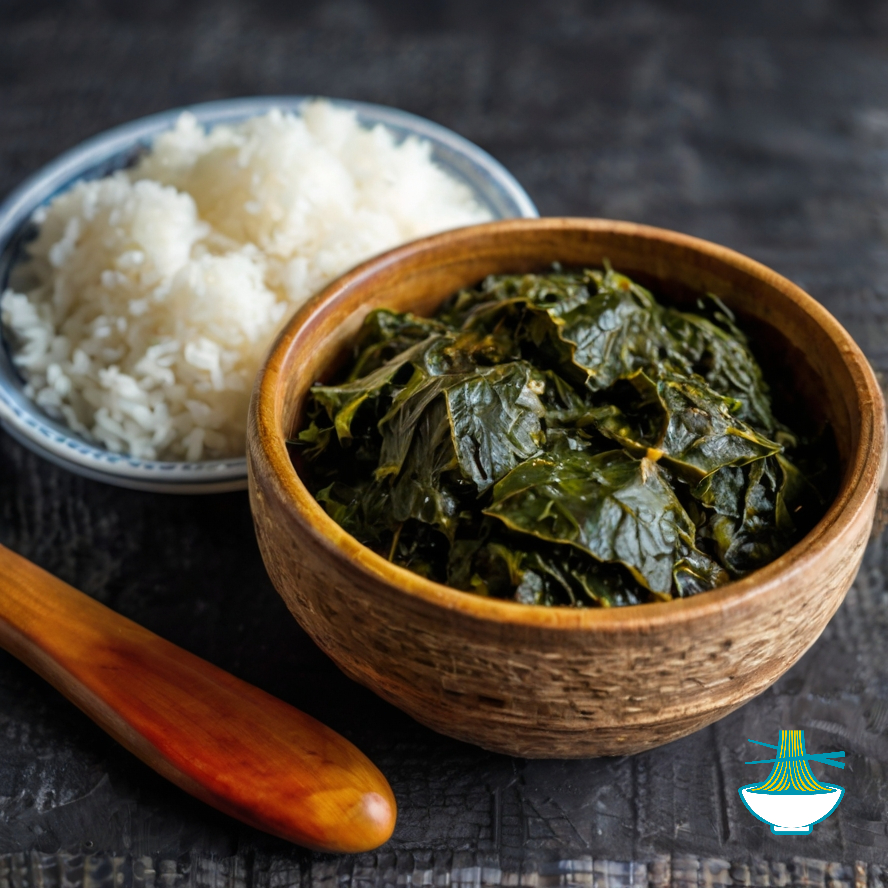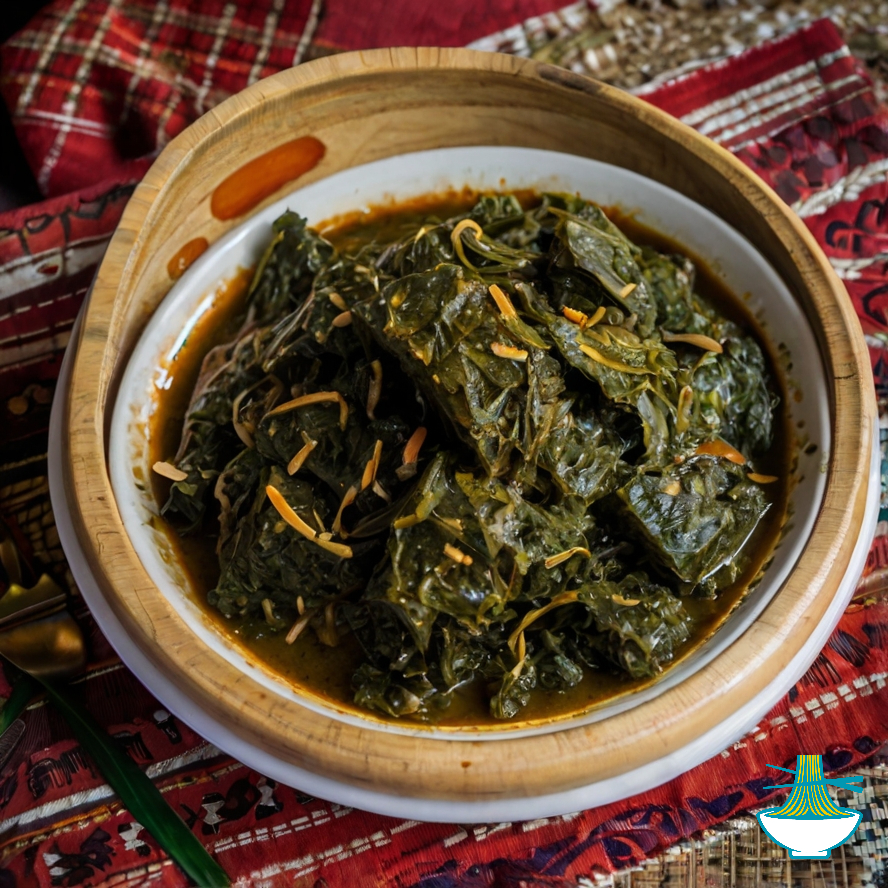Saka-saka, also known as "pondu" or "feuilles de manioc," is a beloved traditional dish from the Central African Republic. This dish features tender cassava leaves simmered with spinach, tomatoes, onions, garlic, and palm oil, creating a rich, flavorful stew. Saka-saka is cherished for its unique taste and nutritional benefits, offering a delicious representation of Central African cuisine that has stood the test of time.

Saka-saka, a staple of Central African cuisine, has deep roots in the region's culinary heritage. Originating from indigenous communities who relied on cassava as a primary food source, the dish evolved with the introduction of new ingredients like tomatoes and spices by Arab and European traders. Saka-saka symbolizes cultural identity and unity, often served at special occasions and communal gatherings. Today, it remains a beloved dish, celebrated for its rich flavors and cultural significance across Central Africa and beyond.
Ingredients
- 2 pounds cassava leaves
- 1 pound spinach leaves
- 1 onion, finely chopped
- 2 tomatoes, diced
- 2 cloves garlic, minced
- 1 red bell pepper, chopped
- 1 scotch bonnet pepper (optional), finely chopped
- 1 cup palm oil
- Salt and pepper to taste
- Water
Instructions
Step 1: Prepare the Leaves
- Thoroughly wash the cassava and spinach leaves.
- Remove any tough stems or veins and finely chop the leaves. Set aside.
Step 2: Blanch the Leaves
- Bring a large pot of water to a boil. Add the chopped cassava and spinach leaves and cook for about 5 minutes to soften and remove any bitterness. Drain and set aside.
Step 3: Cook the Sauce
- Heat the palm oil in a large pot over medium heat.
- Add chopped onions, garlic, and red bell pepper; sauté until soft and fragrant.
- Stir in diced tomatoes and scotch bonnet pepper (if using), and cook for 2-3 minutes.
Step 4: Add the Leaves
- Add the blanched cassava and spinach leaves to the sauce. Stir to combine.
- Reduce heat to low and simmer for 15-20 minutes, stirring occasionally.
Step 5: Season and Adjust Consistency
- Season with salt and pepper to taste. Adjust spiciness by modifying the amount of scotch bonnet pepper.
- Add water if needed to achieve the desired consistency. Simmer for another 5 minutes.
Step 6: Serve
- Serve Saka-saka with fufu or rice, spooned into bowls or plates.
Notes
1. Saka-saka is versatile; you can add meat, fish, or shrimp for extra protein.
2. Adjust the spiciness to your preference.
3. Palm oil provides a distinct flavor but can be substituted with another vegetable oil if necessary.

Nutrition Value:
1. Cassava leaves (2 pounds)
- calories: approximately 560
- carbohydrates: 80 grams
- protein: 64 grams
- fat: 4 grams
- sodium: 120 milligrams
- cholesterol: 0 milligrams
- vitamins: rich in vitamin C and vitamin A
- minerals: contains iron, calcium, and magnesium
- nutritional benefit: high in protein and essential vitamins and minerals, cassava leaves are a good source of antioxidants and help support immune function.
2. Spinach leaves (1 pound)
- calories: approximately 104
- carbohydrates: 16 grams
- protein: 12 grams
- fat: 2 grams
- sodium: 300 milligrams
- cholesterol: 0 milligrams
- vitamins: high in vitamins A, C, and K
- minerals: rich in iron, magnesium, potassium, and folate
- nutritional benefit: spinach is a low-calorie, nutrient-dense vegetable that supports bone health, reduces inflammation, and boosts the immune system.
3. Onion (1, finely chopped)
- calories: approximately 44
- carbohydrates: 10 grams
- protein: 1 gram
- fat: 0 grams
- sodium: 4 milligrams
- cholesterol: 0 milligrams
- vitamins: contains vitamin C and vitamin B6
- minerals: small amounts of potassium and manganese
- nutritional benefit: onions are low in calories and contain antioxidants that help in reducing inflammation and may lower cholesterol levels.
4. Tomatoes (2, diced)
- calories: approximately 44
- carbohydrates: 10 grams
- protein: 2 grams
- fat: 0.5 grams
- sodium: 10 milligrams
- cholesterol: 0 milligrams
- vitamins: high in vitamin C and vitamin K
- minerals: contains potassium and manganese
- nutritional benefit: tomatoes are rich in antioxidants like lycopene, which may reduce the risk of heart disease and cancer.
5. Garlic (2 cloves, minced)
- calories: approximately 9
- carbohydrates: 2 grams
- protein: 0.5 grams
- fat: 0 grams
- sodium: 1 milligram
- cholesterol: 0 milligrams
- vitamins: contains vitamin C and B6
- minerals: small amounts of selenium, manganese, and calcium
- nutritional benefit: garlic is known for its immune-boosting properties and its potential to lower blood pressure and cholesterol levels.
6. Red bell pepper (1, chopped)
- calories: approximately 31
- carbohydrates: 7 grams
- protein: 1 gram
- fat: 0.5 grams
- sodium: 2 milligrams
- cholesterol: 0 milligrams
- vitamins: high in vitamin C and vitamin A
- minerals: contains potassium and folate
- nutritional benefit: red bell peppers are rich in antioxidants and vitamins that support eye health and help in maintaining healthy skin.
7. Scotch bonnet pepper (1, optional, finely chopped)
- calories: approximately 18
- carbohydrates: 4 grams
- protein: 1 gram
- fat: 0 grams
- sodium: 3 milligrams
- cholesterol: 0 milligrams
- vitamins: high in vitamin C
- minerals: contains small amounts of potassium and magnesium
- nutritional benefit: adds flavor and spiciness, with potential benefits for metabolism and pain relief.
8. Palm oil (1 cup)
- calories: approximately 1909
- carbohydrates: 0 grams
- protein: 0 grams
- fat: 216 grams
- sodium: 0 milligrams
- cholesterol: 0 milligrams
- vitamins: contains vitamin E
- minerals: small amounts of magnesium
- nutritional benefit: palm oil is a source of healthy fats and vitamin E, though it should be consumed in moderation due to its high caloric content.
9. Salt and pepper (to taste)
- calories: 0
- carbohydrates: 0 grams
- protein: 0 grams
- fat: 0 grams
- sodium: varies depending on amount used
- cholesterol: 0 milligrams
- vitamins: none
- minerals: salt contains sodium; pepper has trace amounts of calcium and iron
- nutritional benefit: salt enhances flavor and provides essential sodium, while pepper adds spice and can aid in digestion.
10. Water
- calories: 0
- carbohydrates: 0 grams
- protein: 0 grams
- fat: 0 grams
- sodium: 0 milligrams
- cholesterol: 0 milligrams
- vitamins: none
- minerals: none
- nutritional benefit: necessary for hydration and cooking; contains no calories or nutrients.


Comments